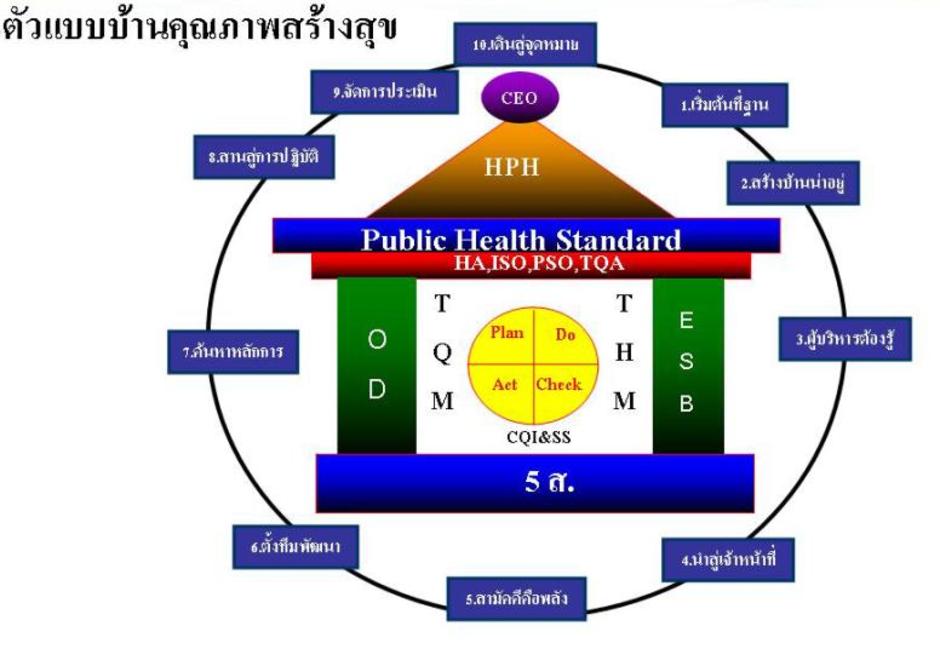The Quality and Healthy House Model
Bantak hospital(By Dr. Phichet Banyati, The director)developed “The Quality and Healthy House Model” for the role model to quality improvement and Healthy promoting hospital. This model was developed by integration a lot of quality tools and built it as the house. The 5 S Japanese principle is the floor to make the staff have personal mastery and increase hospital productivity. The Organization development (OD) and Excellence service behavior (ESB) are wall for building teamwork and good behavioral services. The body of this house compound from Total Quality Management (TQM) and Total Healthy Management (THM) with Suggestion system (SS) and Continuous Quality Improvement (CQI). The 4 doors are Deming’s cycle : Plan-Do-Check-Act (PDCA). The ceiling is the criteria of quality management system, may be Hospital accreditation (HA), The International standard of Organization (ISO), Thailand Quality Award (TQA : Adjusted from MBNQA) or others. The roof is Public Health Service Standard. In Thai model’s house, because of hot and rainy, has the second triangle roof called in Thai “NaJua” for relieving hot, good ventilation and freshy , in this model is Health promoting hospital criteria. The top goals or ultimate outcomes of this model are CEO that come from Healthy Citizen/customer, Happiness Employee and Survival Hospital. The application of this model uses 10 steeps, are :
1. Starting with Basic concepts of 5 S Japanese principle : Seiri (Organization/Screen), Seiton( Neatness/Systematic) , Seiso (Cleaning/Spotless), Seiketsu (Standardization/Sanitary), Shitsuke (Discipline/Self-discipline)
2. Healthy and Happy workplace : make the hospital as a home by hospital structure, rules/regularities, infrastructure/environment, hospital welfare,etc.3. Administrator’s competency and commitment :
4 management functions as planning, organizing, leading, controlling (POLC) and willing to quality improving. Using strategic management and result-based management.4. Focus on staffs : participation to setting shared vision, make them have competency and commitment to quality improvement(QI) by training for simplify the QI technique.
5. Cooperation building : apply the behavioral science to change staffs’ behavior in working with teamwork and good behavioral services.
6. Team and committee building : apply 3 balanced team with quality steering team, quality support/facilitating team and quality improving team.
7. Define/simplify core concepts and core value : quality is response to customer needs and expectations, the staffs must do their own work the best with customer focus, team-working and continuous improvement.
8. Application from concepts to practice : do the relative 3 steps that risk management, quality assurance and quality culture making by CQI. Works will be quality when they do the best routine work, talk together and regular review.
9. Evaluation : both self assessment and third party assessment. . Find the opportunity for improvement from internal & external surveys, customer voices and feedback.
10. Goals attainment: CEO (Healthy Citizen/customer, Happiness Employee and Survival Hospital)
Note : The picture of this Model is show below.
<center><img src= <p>gotoknow.org/file/tingbanyati/QHHousemodel.JPG</p>></center></br><br>
ความเห็น (1)
I can link model,but it can't show in this paper.
